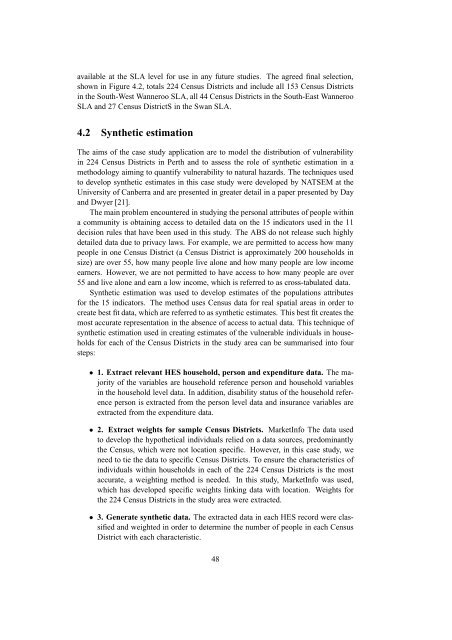Quantifying Social Vulnerability: A methodology for ... - EarthByte
Quantifying Social Vulnerability: A methodology for ... - EarthByte
Quantifying Social Vulnerability: A methodology for ... - EarthByte
You also want an ePaper? Increase the reach of your titles
YUMPU automatically turns print PDFs into web optimized ePapers that Google loves.
available at the SLA level <strong>for</strong> use in any future studies. The agreed final selection,shown in Figure 4.2, totals 224 Census Districts and include all 153 Census Districtsin the South-West Wanneroo SLA, all 44 Census Districts in the South-East WannerooSLA and 27 Census DistrictS in the Swan SLA.4.2 Synthetic estimationThe aims of the case study application are to model the distribution of vulnerabilityin 224 Census Districts in Perth and to assess the role of synthetic estimation in a<strong>methodology</strong> aiming to quantify vulnerability to natural hazards. The techniques usedto develop synthetic estimates in this case study were developed by NATSEM at theUniversity of Canberra and are presented in greater detail in a paper presented by Dayand Dwyer [21].The main problem encountered in studying the personal attributes of people withina community is obtaining access to detailed data on the 15 indicators used in the 11decision rules that have been used in this study. The ABS do not release such highlydetailed data due to privacy laws. For example, we are permitted to access how manypeople in one Census District (a Census District is approximately 200 households insize) are over 55, how many people live alone and how many people are low incomeearners. However, we are not permitted to have access to how many people are over55 and live alone and earn a low income, which is referred to as cross-tabulated data.Synthetic estimation was used to develop estimates of the populations attributes<strong>for</strong> the 15 indicators. The method uses Census data <strong>for</strong> real spatial areas in order tocreate best fit data, which are referred to as synthetic estimates. This best fit creates themost accurate representation in the absence of access to actual data. This technique ofsynthetic estimation used in creating estimates of the vulnerable individuals in households<strong>for</strong> each of the Census Districts in the study area can be summarised into foursteps:• 1. Extract relevant HES household, person and expenditure data. The majorityof the variables are household reference person and household variablesin the household level data. In addition, disability status of the household referenceperson is extracted from the person level data and insurance variables areextracted from the expenditure data.• 2. Extract weights <strong>for</strong> sample Census Districts. MarketInfo The data usedto develop the hypothetical individuals relied on a data sources, predominantlythe Census, which were not location specific. However, in this case study, weneed to tie the data to specific Census Districts. To ensure the characteristics ofindividuals within households in each of the 224 Census Districts is the mostaccurate, a weighting method is needed. In this study, MarketInfo was used,which has developed specific weights linking data with location. Weights <strong>for</strong>the 224 Census Districts in the study area were extracted.• 3. Generate synthetic data. The extracted data in each HES record were classifiedand weighted in order to determine the number of people in each CensusDistrict with each characteristic.48
















